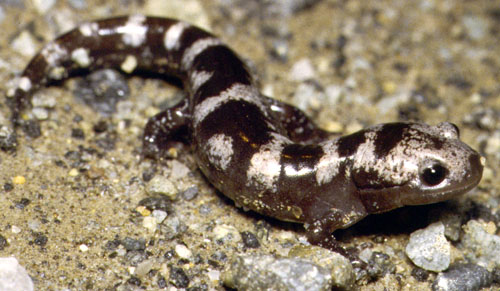|
| Query: mole salamander | Result: 7th of 10 | |
Marbled Salamander (Ambystoma opacum) - Wiki
| Subject: | Marbled Salamander (Ambystoma opacum) - Wiki
| |

| Resolution: 500x291
File Size: 69003 Bytes
Date: 2006:03:22 10:17:57
Upload Date: 2007:01:09 01:33:54
|
Marbled Salamander
From Wikipedia, the free encyclopedia
[Photo] Marbled Salamander, Ambystoma opacum, likely a female--bands are gray (whiter in males). Location: Durham County, North Carolina, United States. Roll 165. Date 1998-10-09. Photograph taken by Patrick Coin http://commons.wikimedia.org/wiki/User:Cotinis
The Marbled Salamander (Ambystoma opacum) is a widespread species of Mole salamander found in the southeastern United States.
Description
The Marbled Salamander is a stocky, boldly banded salamander. The bands of females tend to be gray, while those of males are more white. Adults can grow to about 11 cm, (4 inches), a bit small compared to other members of its genus. Like most of the Mole salamanders, it is secretive, spending most of its life under logs or in burrows. It is most frequently encountered when moving towards breeding ponds in the fall.
Habitat and range
The Marbled Salamander is found in the southeastern United States, from southern New England to northern Florida, and west to Illinois and Texas. Its habitat is damp woodlands, forests, and places where the dirt is soft and wet. Seasonally flooded areas are essential for breeding, but the salamanders do not normally enter the water.
Life cycle
Adults spend most of their lives underground, and in deep leaf litter, but wander at night during the breeding season. Breeding takes place in fall, typically September to December. Females lay eggs in clusters of up to 120 under logs or in clumps of vegetation in low areas that are likely to flood during winter rains.They dig a small depression in soft dirt and lay the eggs in it. Eggs hatch the same fall or winter if rains come, but they may overwinter and hatch the following spring. Larvae typically mature in as little as two months in the southern part of their range, but take up to six months to mature in the northern part.
Marbled Salamanders, like other members of this genus, are reported to have relatively long life spans, ten years or more.
Feeding
Adults take terrestrial invertebrates such as worms, insects, centipedes, and mollusks (snails, slugs). Larvae take small aquatic animals (zooplankton), but larger individuals will take eggs and larvae of other amphibians as well.
http://en.wikipedia.org/wiki/Marbled_Salamander
| The text in this page is based on the copyrighted Wikipedia article shown in above URL. It is used under the GNU Free Documentation License. You may redistribute it, verbatim or modified, providing that you comply with the terms of the GFDL. |
|
Comments |
|---|
| | Guest |
|
| i hate salamanders |
| | Guest |
|
| salamanders suck |
| | Guest |
|
| wowwwwww |
| | Guest |
|
| its not enogh info nd u ppl suck for sayin that... |
^o^
Animal Pictures Archive for smart phones
^o^
|
|
|

